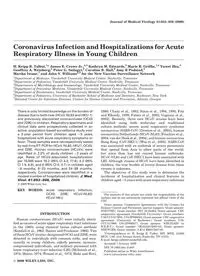
2009 Coronavirus infection and hospitalizations for acute respiratory illness in young children PDF
Preview 2009 Coronavirus infection and hospitalizations for acute respiratory illness in young children
Journal of Medical Virology 81:853–856 (2009) Coronavirus Infection and Hospitalizations for Acute Respiratory Illness in Young Children H. Keipp B. Talbot,1* James E. Crowe Jr.,2,3 Kathryn M. Edwards,2 Marie R. Griffin,1,4 Yuwei Zhu,5 Geoffrey A. Weinberg,6 Peter G. Szilagyi,6 Caroline B. Hall,6 Amy B Podsiad,2 Marika Iwane,7 and John V. Williams2,3 for the New Vaccine Surveillance Network 1Department of Medicine, Vanderbilt University Medical Center, Nashville, Tennessee 2Department of Pediatrics, Vanderbilt University Medical Center, Nashville, Tennessee 3Departments of Microbiology and Immunology, Vanderbilt University Medical Center, Nashville, Tennessee 4Department of Preventive Medicine, Vanderbilt University Medical Center, Nashville, Tennessee 5Department of Biostatistics, Vanderbilt University Medical Center, Nashville, Tennessee 6Department of Pediatrics, University of Rochester School of Medicine and Dentistry, Rochester, New York 7National Center for Infectious Diseases, Centers for Disease Control and Prevention, Atlanta, Georgia There is only limited knowledge on the burden of disease due to both new (HCoV-NL63 and HKU-1) and previously discovered coronaviruses (OC43 and 229E) in children. Respiratory specimens and clinical data were prospectively collected in an active, population-based surveillance study over a 2-year period from children aged <5 years hospitalized with acute respiratory symptoms or fever. These samples were retrospectively tested by real-time RT-PCR for HCoV-NL63, HKU1, OC43, and 229E. Human coronaviruses (HCoVs) were identified in 2.2% of study children <2 years of age. Rates of HCoV-associated hospitalization per 10,000 were 10.2 (95% CI 4.3, 17.6), 4.2 (95% CI 1.9, 6.9), and 0 (95% CI 0, 3.7) in children aged <6 months, 6–23 months, and 24–59 months, respectively. Coronaviruses were identified in a modest number of hospitalized children. J. Med. Virol. 81:853–856, 2009. � 2009 Wiley-Liss, Inc. KEY WORDS: acute respiratory infection; OC43; 229E; HCoV-NL63; HCoV-HKU INTRODUCTION Human coronaviruses (HCoV) were initially identi- fied as causes of acute upper respiratory tract infections in the 1960s using classical tissue culture methods [Kendall et al., 1962; Hamre and Procknow, 1966]. Two of these HCoV strains, designated OC43 and 229E, were detected in individuals with common colds, and occa- sionally in young children, elderly persons, immuno- compromised individuals, and military personnel with lower respiratory tract infection (LRI) [McIntosh et al., 1974; Monto, 1974; Wenzel et al., 1974; Riski and Hovi, 1980; Chany et al., 1982; Sizun et al., 1994, 1995; Folz and Elkordy, 1999; Falsey et al., 2002; Gagneur et al., 2002]. Recently, three new HCoV strains have been identified using both molecular and traditional culture methods: severe acute respiratory syndrome coronavirus (SARS-CoV) [Drosten et al., 2003], human coronavirus Netherlands (HCoV-NL63) [Fouchier et al., 2004; van der Hoek et al., 2004], and human coronavirus Hong Kong (CoV-HKU1) [Woo et al., 2005]. SARS-CoV was associated with an outbreak of severe pneumonia that spread from Asia to other parts of the world, but since then has not caused human outbreaks. HCoV-NL63 and CoV-HKU1 have been associated with LRI. Although strains of HCoV have been identified in children, the true burden of severe disease from these viruses is unknown. The objectives of this study were to determine the incidence of hospitalization and clinical features in children aged <5 years with acute respiratory infections The contents of this article are solely the responsibility of the authors and do not necessarily represent the official views of the CDC. Grant sponsor: Cooperative Agreements with the Centers for Disease Control and Prevention (partial support); Grant sponsor: NIH/VTEU; Grant number: N01 AI-25462; Grant sponsor: CDC cooperative agreement (Vanderbilt University); Grant numbers: U38/CCU417958, U01/IP000022; Grant sponsor: CDC cooperative agreement (University of Rochester); Grant numbers: U38/ CCU217969, U01/IP000017; Grant sponsor: NIH/NIAID (to H.K.B.T.); Grant number: 5K23AI074863-02; Grant sponsor: NIH/NCRR; Grant number: 5 K12 RR017697-05. *Correspondence to: H. Keipp B. Talbot, MD, MPH, A2200 MCN, 1161 21st Avenue South, Nashville, TN 37232. E-mail:
